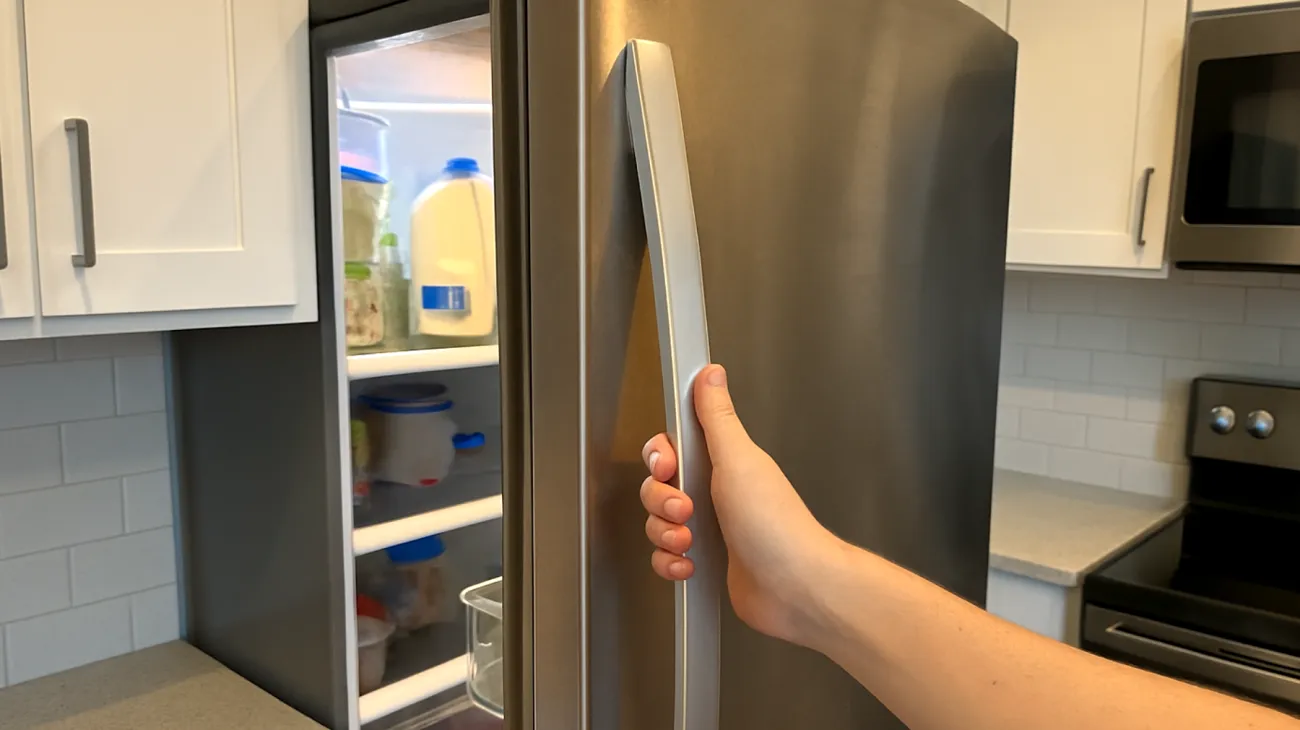The Hidden Science of Refrigeration Airflow
When a refrigerator struggles to maintain low temperatures, it’s rarely a matter of wear and tear alone. More often, it’s a silent result of airflow disruption, an easily overlooked detail that can dramatically affect both appliance performance and food safety.
A fridge that’s too full, poorly organized, or has its air vents blocked behaves deceptively: it hums, lights up, and seems functional—until you find your yogurt warm or vegetables prematurely spoiled. The issue is less mechanical than thermodynamic: air needs space to move, and even a well-functioning compressor can’t compensate for stale air trapped by poor circulation.
At the core of refrigeration is a fluid dance between warm and cold air. Your fridge maintains low temperatures not by freezing everything, but by continuously cycling air cooled by the evaporator fan. That cooled air flows from strategically placed vents, usually at the back top of the refrigerator compartment and sometimes within drawers or alongside the walls.
This circulation system operates on principles of convective heat transfer, where cooler, denser air naturally sinks while warmer air rises. The engineering design of modern refrigerators harnesses this natural phenomenon while using mechanical fans to ensure consistent air movement throughout all compartments. Understanding how thermodynamics governs this process reveals why proper organization matters so much for food safety.
When airflow moves freely, temperature balances evenly across compartments. The physics involved mirror those found in large-scale HVAC systems, scaled down to manage the confined space of a household appliance. But when vents are covered—think stacked containers or plastic bags—cold air stalls, creating a cascade of thermal inefficiencies.
Blocked Air Vents Silently Sabotage Temperature Balance
The most insidious aspect of airflow blockage is its stealth nature. Unlike a broken compressor or failed thermostat, blocked vents create problems that develop gradually, often going unnoticed until food spoilage becomes obvious.
These inconsistencies aren’t just annoying: they accelerate spoilage and encourage bacterial growth. For perishable foods like meats, dairy, or leftovers, a few degrees can mean the difference between extended freshness and silent mold development. The temperature danger zone, well-documented in food safety literature, becomes a very real concern when internal air circulation fails.
The thermal dynamics at play involve more than simple temperature measurement. When air cannot circulate properly, humidity levels become uneven, creating pockets where condensation accelerates bacterial growth. This moisture accumulation often occurs in the very areas where temperature control is already compromised.
The most common behaviors that block airflow include:
- Placing containers directly against back-wall vents
- Stacking items tightly from top to bottom without space between
- Overstuffed drawers that block internal ducting designs
- Misplacing large trays or pizza boxes that press against side exhaust ports
Understanding why these placements are problematic requires recognizing that refrigerator designers create specific airflow paths. These paths aren’t arbitrary—they’re calculated to ensure that cooled air reaches every corner of the storage space before returning to the evaporator for re-cooling.
The fix is deceptively low-tech: visual airflow gaps. Always aim for at least an inch of space between the walls and food items, especially where vents or fans are located. This simple shift redistributes air evenly and allows the built-in thermal regulation to do its job properly.
Temperature Sensors and the Illusion of Control
Most people correctly set fridge temperatures to the generally accepted range for safe food storage. But that number alone doesn’t guarantee freshness if heat lingers in corners or drawers. The fundamental issue lies in how temperature measurement works within the confined space of a refrigerator.
Because temperature sensors—usually located near the fan—measure only a specific region, not the full internal environment. If air isn’t circulating effectively, these sensors give a false sense of balance. While the sensor may read the target temperature near the fan, a tightly packed drawer may hold at significantly higher temperatures—warm enough for microbes to grow unhindered.
This limitation of single-point temperature measurement represents a fundamental challenge in refrigeration design. Engineers must balance the cost and complexity of multiple sensors against the reality that most temperature problems stem from user behavior rather than equipment failure.
More so, some fridges use dual evaporator systems to separately cool the fridge and freezer. That design improves humidity control but makes vent obstruction even more impactful, as each compartment depends on optimized airflow paths built into the walls.
Besides repositioning items, this is where internal thermometers make a difference. Cheap and widely available, they help identify hotspots over time and allow you to map out where heat lingers. Once you locate these zones, you can address storage errors that cause them.
The Energy Economics of Poor Airflow
Understanding the relationship between airflow and energy consumption reveals why proper refrigerator organization matters beyond food safety. When air circulation is compromised, the entire system works harder to maintain target temperatures, creating a ripple effect that impacts both utility bills and appliance longevity.

A few smart storage strategies massively improve air distribution:
- Use transparent bins to group items and promote vertical air movement
- Avoid stacking items fully across shelves—leave horizontal pathways
- Reserve the central mid-shelf zone for the most temperature-sensitive items
- Store leftovers in low-profile containers that cool down faster
You’re not just organizing; you’re engineering airflow around what you eat. This perspective transforms routine refrigerator maintenance from a chore into an application of thermal management principles.
Overcrowding Increases Energy Consumption and Shortens Food Lifespan
Filling every inch of space may seem practical—especially after a grocery run—but it creates an unintended consequence: the fridge must work harder and longer to maintain the same average temperature. The thermodynamics involved become increasingly complex as storage density increases.
Compressors are not particularly intelligent. When warm air enters, the thermostat signals the system to keep cooling. But if that cool air can’t circulate, heat pockets remain, misleading the control board to continue cycling. This creates a feedback loop where the refrigerator runs more frequently without achieving better results.
You’ll notice this in two ways: higher electricity bills and a fridge that seems to cycle more frequently but fails to chill effectively. The increased energy consumption isn’t just wasteful—it accelerates wear on mechanical components, potentially shortening the appliance’s lifespan.
One of the most telling indicators of an airflow issue is condensation where it shouldn’t be—under drawers, or around the door frame. This usually indicates that warm humid air lingers in those zones instead of being pulled into the cooling stream.
The Physics of Cold Air Distribution
A phenomenon known as “cold air waterfall”—where cooled air drops from upper vents and spills to the bottom—is only effective when nothing obstructs that drop. This natural convection process forms the backbone of refrigerator thermal management, relying on density differences between warm and cold air.
Once airflow turns turbulent due to obstructions, it diminishes cooling efficiency and disturbs humidity regulation. Turbulent flow patterns prevent the orderly circulation that refrigerator designers depend upon, creating random hot and cold spots that no amount of mechanical refrigeration can fully compensate for.
Even minor door obstructions disrupt thermal equilibrium in ways that extend far beyond the obvious problem of letting cold air escape. Many airflow issues originate during frequent fridge access, especially when items placed in bins or on the interior door jostle and block proper closing.
Repeated partial closures, even if just slightly ajar, introduce warm air continuously. The result? Moisture builds up, the compressor runs longer, and certain sections experience repeated thaw–freeze mini-cycles, which damage even resilient ingredients like cheese or eggs.
Two overlooked culprits include tall bottles stored in the door that tip inward and block sealing, plus overloaded drawers that push forward and interfere with the closing of the lower compartment. Modern fridges include gaskets and magnetic seals designed to press firmly shut, but they can be misaligned without visible symptoms.
Keeping a thin piece of paper in the door and testing how easily it slides across the seal is a reliable method: if there’s little resistance, airflow is escaping. This simple test reveals whether the sophisticated sealing system is functioning as designed.
Transforming Refrigeration Into Food Preservation
Don’t just rearrange for beauty—arrange with airflow paths and closing geometry in mind. This shift in perspective acknowledges that refrigerator organization is actually an exercise in applied thermodynamics, where every decision affects the overall system performance.
The cumulative effect of proper airflow management extends beyond immediate food safety concerns. Energy efficiency improvements compound over time, while reduced temperature fluctuations minimize food waste and extend the useful life of stored items. Vegetables retain texture and nutrients longer, prepared meals stay safer, and appliance lifespan is extended due to optimized compressor workload.
Preventing spoilage and minimizing energy usage isn’t a matter of tech upgrades or professional repair. It’s about treating the interior space of your fridge as a dynamic environment, not a storage cabinet. This perspective acknowledges the sophisticated engineering that goes into modern refrigeration while recognizing that user behavior ultimately determines system effectiveness.
Each adjustment builds on the last. When you prevent vent blockages, you equalize temperature. When you avoid overstuffing, you improve humidity control. When airflow is optimized, your fridge refrigerates—not just runs cold. And that extends far beyond freshness into the realm of household efficiency and environmental responsibility.
Airflow isn’t a technicality—it’s the physiological backbone of proper refrigeration. Master that, and your fridge will quietly maintain a level of daily comfort, safety, and efficiency that pays off week after week. Sometimes, the most overlooked square meter in your kitchen hides your biggest opportunities for improving both livability and sustainability. Let airflow do what it’s built to do—if you let it.
Table of Contents

